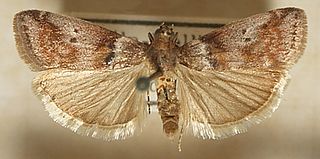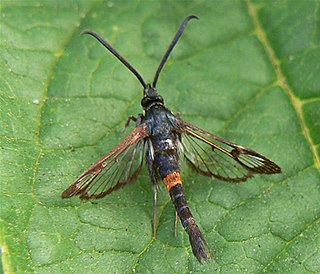
The codling moth is a member of the Lepidopteran family Tortricidae. They are major pests to agricultural crops, mainly fruits such as apples and pears, and a codling moth larva is often called an "apple worm". Because the larvae are not able to feed on leaves, they are highly dependent on fruits as a food source and thus have a significant impact on crops. The caterpillars bore into fruit and stop it from growing, which leads to premature ripening. Various means of control, including chemical, biological, and preventive, have been implemented. This moth has a widespread distribution, being found on six continents. Adaptive behavior such as diapause and multiple generations per breeding season have allowed this moth to persist even during years of bad climatic conditions.

Acrobasis consociella is a moth of the family Pyralidae. It is found in Europe.

Synanthedon myopaeformis is a moth of the family Sesiidae and the order Lepidoptera. In Europe it is known as the red-belted clearwing and in North America as the apple clearwing moth. The larvae create galleries under the bark of fruit trees, especially old trees with damaged trunks. During this process, the larvae cause significant damage to host trees. Particular attention has been paid to the damage they cause to apple trees. Their status as a pest of apple orchards has led to many research projects aimed at controlling populations of the moth. This moth is native to Europe, the Near East and North Africa. Recently, the moth was introduced into North America, being first detected in Canada in 2005. There are several organisms that threaten the larvae, including parasitoids, nematodes, and bacteria.

Acrobasis is a genus of moths of the family Pyralidae.

Acrobasis vaccinii, the cranberry fruitworm, is a moth of the family Pyralidae described by Charles Valentine Riley in 1884. It is found in North America from Nova Scotia to Florida and from Wisconsin to Texas, it is introduced in the state of Washington.

Acrobasis glaucella is a moth of the family Pyralidae described by Otto Staudinger in 1859. It is found in most of Europe.

Cydia pyrivora, the pear fruit moth or pear tortricid, is a moth of the family Tortricidae. It is found in Latvia, the Czech Republic, Slovakia, Sardinia, Sicily, the Italian mainland, Austria, Hungary, Yugoslavia, Romania, Bulgaria, Algeria, the island of Crete in Greece, Ukraine and southern and central Russia.
Stigmella oxyacanthella is a moth of the family Nepticulidae, found in Europe and North America. The larvae are leaf miners feeding inside the leaves of trees and shrubs, such as hawthorn, apple and pear.

Acrobasis angusella, the hickory leafstem borer or leafstem borer, is a species of snout moth. It was described by Augustus Radcliffe Grote in 1880, and is known from Quebec, Canada, and the north-eastern United States.
Acrobasis evanescentella is a species of snout moth in the genus Acrobasis. It was described by Harrison Gray Dyar Jr., in 1908, and is known from southern Georgia and Florida.

Acrobasis tricolorella, the destructive prune worm or tricolored acrobasis moth, is a species of snout moth in the genus Acrobasis. It was described by Augustus Radcliffe Grote in 1878, and is known from southern Canada and northern United States.

Acrobasis indigenella, the leaf crumpler, is a species of snout moth in the genus Acrobasis. It was described by Philipp Christoph Zeller in 1848, and is known from eastern North America.
Acrobasis bithynella is a species of snout moth in the genus Acrobasis. It was described by Philipp Christoph Zeller in 1848, and is known from France, the Iberian Peninsula, Italy, Croatia, Crete, Turkey and Russia.

Acrobasis advenella is a species of snout moth in the genus Acrobasis. It was described by Johann Zincken in 1818 and is found in most of Europe.
Acrobasis cymindella is a species of snout moth in the genus Acrobasis. It was described by Ragonot in 1893. It is found in Russia.
Acrobasis injunctella is a species of snout moth in the genus Acrobasis. It was described by Hugo Theodor Christoph in 1881. It is found in Russia and China.

Acrobasis legatea is a species of snout moth in the genus Acrobasis. It was described by Adrian Hardy Haworth in 1811. It is found in most of Europe, except the north, east to Russia and Kazakhstan.
Acrobasis niveicinctella is a species of snout moth in the genus Acrobasis. It was described by Ragonot in 1887. It is found in Russia and Turkmenistan.
Acrobasis squalidella is a species of snout moth in the genus Acrobasis. It was described by Hugo Theodor Christoph in 1881. It is found in Russia and Japan.
Synanthedon flaviventris, the sallow clearwing, is a moth of the family Sesiidae. The larvae form pear-shaped galls on sallows.













